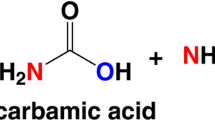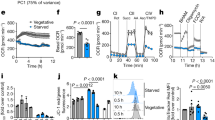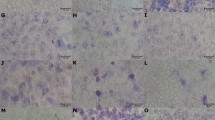Abstract
Metal-binding chelators may interact with biological systems by either of two mechanisms: they may combine with an essential metal, which can be either freely dissociated or part of an enzyme prosthetic group, or they may react with a metal ion to form a biologically reactive metal–chelate complex1. As trace metals are always present as contaminants in serum-supplemented culture media used to study chelating agents, it is frequently difficult to distinguish between the two possibilities. Here we describe the use of a nontoxic, copper-specific chelating agent, bathocuproine sulphonate2,3 (Fig. 1) which, by combining with available endogenous copper in a tissue culture preparation, abolished the toxicity of three structurally unrelated chelating agents. These three agents may therefore be considered to be biologically active by the second mechanism.
This is a preview of subscription content, access via your institution
Access options
Subscribe to this journal
Receive 51 print issues and online access
$199.00 per year
only $3.90 per issue
Buy this article
- Purchase on Springer Link
- Instant access to full article PDF
Prices may be subject to local taxes which are calculated during checkout
Similar content being viewed by others
References
Albert, A. in Selective Toxicity 5th edn, 334–391 (Chapman & Hall, London, 1972).
Blair, D. & Diehl, H. Talanta 7, 163–174 (1961).
Landers, J. W. & Zak, B. Am. J. clin. Path. 29, 590–592 (1958).
Thorn, G. D. & Ludwig, R. A. The Dithiocarbamates and Related Compounds, 169–192 (Elsevier, Amsterdam, 1962).
Reid, E. E. Organic Chemistry of Bivalent Sulfur Vol. 4, 196–256 (Chemical Publishing, New York, 1962).
Rigas, D. A., Eginitis-Rigas, C., Bigley, R. H., Stankova, L. & Head, C. Int. J. Radiat. Biol. 38, 257–266 (1980).
Heikkila, R. E., Cabbat, F. S. & Cohen, G. J. biol. Chem. 251, 2182–2185 (1976).
Pottathil, R., Chandrabose, K. A., Cuatrecasas, P. & Lang, D. J. Proc. natn. Acad. Sci. U.S.A. 78, 3343–3347 (1981).
Booth, B. A. & Sartorelli, A. C. Molec. Pharmac. 3, 290–302 (1967).
Van Giessen, G. J., Crim, J. A., Petering, D. H. & Petering, H. G. J. natn. Cancer Inst. 51, 139–146 (1973).
Berger, N. A., Johnson, E. S. & Skinner, A. M. Sr. Expl Cell Res. 96, 145–155 (1975).
Falchuk, K. H. & Krishan, A. Cancer Res. 37, 2050–2056 (1977).
James, B. R. & Williams, R. J. P. J. chem. Soc. 2007–2019 (1961).
Hall, J. R., Marchant, N. K. & Plowman, R. A. Aust. J. Chem. 16, 34–41 (1962).
Murthy, Y. K. S., Thiemann, J. E., Coronelli, C. & Semsi, P. Nature 211, 1198 (1966).
Powis, G. & Kovach, J. S. Biochem. Pharmac. 30, 771–776 (1981).
Author information
Authors and Affiliations
Rights and permissions
About this article
Cite this article
Mohindru, A., Fisher, J. & Rabinovitz, M. Bathocuproine sulphonate: a tissue culture-compatible indicator of copper-mediated toxicity. Nature 303, 64–65 (1983). https://doi.org/10.1038/303064a0
Received:
Accepted:
Issue Date:
DOI: https://doi.org/10.1038/303064a0
This article is cited by
-
Mutation of copper binding sites on cellular prion protein abolishes its inhibitory action on NMDA receptors in mouse hippocampal neurons
Molecular Brain (2021)
-
Investigation of the effects of the proton transfer salts of 2-aminopyridine derivatives with 5-sulfosalicylic acid and their Cu(II) complexes on cancer-related carbonic anhydrases: CA IX and CA XII
Chemical Papers (2020)
-
Differential modulation of NMDA and AMPA receptors by cellular prion protein and copper ions
Molecular Brain (2018)
-
Photo-catalytic degradation of methylene blue over nano titanium/nickel oxide prepared from supported Schiff base complex on titanium dioxide
Journal of Materials Science: Materials in Electronics (2016)
-
Dielectrical properties and conduction mechanism of quinoline Schiff base and its complexes
Research on Chemical Intermediates (2016)
Comments
By submitting a comment you agree to abide by our Terms and Community Guidelines. If you find something abusive or that does not comply with our terms or guidelines please flag it as inappropriate.



